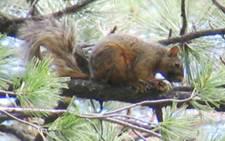Sandy Doumas
Past Graduate Student

-
ENR2
1064 E Lowell St
Tucson, AZ 85719
Factors influencing habitat use by wildlife relative to landscape disturbance
I am interested in factors influencing habitat use by wildlife relative to landscape disturbance, especially fire. Fire is a necessary and recurring disturbance in many ecosystems with profound effects over time on vegetation composition, structure, and landscape pattern. The effects of fire on ecosystems have been complicated by decades of fire suppression followed by reintroduction of fire into fire-deprived ecosystems. Historically, fire-adapted forests were relatively resilient to fire, and some current forest management techniques seek to restore forests to historical composition, structure, and landscape pattern to recreate fire-resiliency. I study habitat use by native wildlife to better understand the response of wildlife to alterations of vegetation structure and pattern following the reintroduction of fire. Specifically, I study habitat use of the Mexican fox squirrel, Sciurus nayaritensis chiricahuae, in conifer forests of the Chiricahua Mountains of SE Arizona, which have experienced several recent fires.
Some of my main research questions include:
- Does burn severity of recent fires and vegetation structure affect squirrel habitat use?
- How are the vegetation characteristics most important to habitat use related to burn severity?
- Does the landscape pattern (patchiness) of burn severity affect squirrel habitat use?
Major Findings: To Date: Mexican fox squirrels feed in forest with open understory and closed canopy cover. Vegetation within home ranges of squirrels is characterized by lower understory density, consistent with the effects of low-severity fire, and larger trees than random locations. These results suggest that return of low-severity fire can help restore habitat for Mexican fox squirrels and other native wildlife species with similar habitat affiliations in forests with a historical regime of frequent, low-severity fire. Habitat use by Mexican fox squirrels is positively associated with moderate burn heterogeneity, suggesting that small areas of severe burn incorporated within low-severity burn may be beneficial to Mexican fox squirrels and other native wildlife species.
Publications
- Doumas, S. L., J. L. Koprowski, and W. O. Noble. 2016. Landscape-level assessment of Abert's squirrel and red squirrel in mixed conifer forest. The Southwestern Naturalist 60:240-246. PDF of Article
- Doumas, S.L., J.L. Koprowski. 2013. Return of fire as a restoration tool: long-term effects of burn severity on habitat use by Mexican fox squirrels. Restoration Ecology 21:133-139. PDF of Article
- Doumas, S. L., and J. L. Koprowski. 2013. Effect of heterogeneity in burn severity on Mexican fox squirrels following the retunr of fire. International Journal of Wildland Fire 22:405-413. PDF of Article


